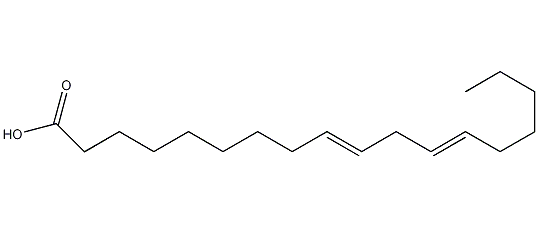
Structural formula
| Business number | 01BB |
|---|---|
| Molecular formula | C18H32O2 |
| Molecular weight | 280.45 |
| label |
(9Z,12Z)-9,12-octadecadienoic acid, Papanic acid, (9Z,12Z)-9,12-Octadecadienoic acid, (Z,Z)-9,12-Octadecadienoic acid, Linolic acid, emulsifier, acidic solvent |
Numbering system
CAS number:60-33-3
MDL number:MFCD00064241
EINECS number:200-470-9
RTECS number:RF9990000
BRN number:1727101
PubChem number:24896279
Physical property data
1. Properties: Colorless to straw-colored liquid.
2. Freezing point (℃): -5
3. Boiling point (℃, 16×133.3pa): 229~230
4. Boiling point (℃ , 0.02×133.3pa): 129
5. Relative density (20℃, 4℃): 0.9022
6. Refractive index (n20D): 1.4699
7. Solubility: soluble in ethanol, ether, chloroform, miscible with dimethylformamide and oils, Insoluble in water and glycerin.
8. Melting point (ºC): -12
9. Flash point (ºC): >110
Toxicological data
1. Skin or eye irritation: Rabbit, skin contact, Standard Draize testTest, 75mg/3D
2. Acute toxicity: rat abdominal cavity LD50: .50mg/kg; mouse oral LC50: >50mg/kg ; Mouse abdominal cavity LC50: 280mg/kg
Ecological data
General remarks
Water hazard level 1 (German regulations) (self-assessment via list) This substance is slightly hazardous to water.
Do not allow undiluted or large amounts of product to come into contact with groundwater, waterways or sewage systems.
Do not discharge materials into the surrounding environment without government permission.
Molecular structure data
1. Molar refractive index: 87.12
2. Molar volume (cm3/mol): 307.5
3. Isotonic specific volume (90.2K ): 744.4
4. Surface tension (dyne/cm): 34.3
5. Polarizability (10-24cm3): 34.53
Compute chemical data
1. Reference value for calculation of hydrophobic parameters (XlogP): 6.8
2. Number of hydrogen bond donors: 1
3. Number of hydrogen bond acceptors: 2
p>
4. Number of rotatable chemical bonds: 14
5. Number of tautomers:
6��� Topological molecular polar surface area (TPSA): 37.3
7, Number of heavy atoms: 20
8, Surface charge: 0
9, Complexity : 267
10. Number of isotope atoms: 0
11. Number of determined atomic stereocenters: 0
12. Number of uncertain atomic stereocenters: 0
13. Determined number of chemical bond stereocenters: 2
14. Uncertain number of chemical bond stereocenters: 0
15. Number of covalent bond units :1
Properties and stability
1. Easily oxidized in air.
2. Exist in flue-cured tobacco leaves, burley tobacco leaves, oriental tobacco leaves and smoke.
Storage method
Packed in stainless steel or aluminum drums. A certain amount of antioxidant VE (or tert-butyl-p-hydroxyanisole) should be added during storage. Store in a cool and ventilated place, avoid direct sunlight, and away from heat sources and oxidants. Store and transport as general chemicals. Storage temperature 2~8ºC
Synthesis method
1. Linoleic acid exists in animal fat together with other fatty acids in the form of glyceride. The content of animal fat is generally low, such as butter1.8%, lard is6%;Some vegetable oils have higher content, such as peanut oil26%, vegetable oil is15.8%, and the fatty acids contained in soybeans are mainly linoleic acid. The general composition of soybean oil fatty acids is as follows: Oleic acid 15-33%Linoleic acid 53-56%Linolenic acid 5-9%Palmitic acid 7-11%Stearic acid 2-6%C20Above acid0.3-3%Soybean oil contains about 5-10% during the refining process‘s oily feet and soapy feet are born. Half of the soybean oil soap stock is useful fatty acids, and the fatty acid composition of the soap stock is basically the same as that of soybean oil. Therefore, using soybean oil soap stock to extract linoleic acid is an important way to comprehensively utilize soybean oil.

2.Extraction method using corn oil as raw material

3. Oxidation of selenium or nitrogen at 200ºC When treated with chemicals, it is converted into linoleic acid. During hydrogenation, it is first converted into oleic acid and octadecene-12-acid, and then into stearic acid.
4. Tobacco: OR, 44; FC, 9, 13, 18, 19, 38, 41, 44, 50; OR, 26; BU, 9; BU, OR, 18; BU, 10 ;BU,OR,19.
Purpose
1. Mainly used as raw material for the production of paints and inks, and can also be used to produce products such as polyamide, polyester and polyurea. Because it has the effect of reducing cholesterol and blood lipids in human blood, it can be used as a raw material for drugs to treat atherosclerosis (such as Yishouning, Maitong, etc.).
2.Refined linoleic acid is esterified with methanol and hydrogenated to produce unsaturated fatty alcohol. As a variety of surface-active raw materials, it is used in detergents, shampoos, and cosmetics. Linoleic acid sodium or potassium salt is one of the ingredients of soap and can be used as an emulsifier. Linoleic acid is also a raw material for pharmaceuticals.

 微信扫一扫打赏
微信扫一扫打赏

